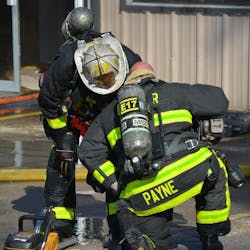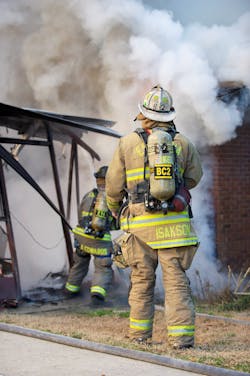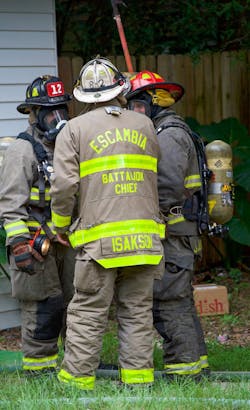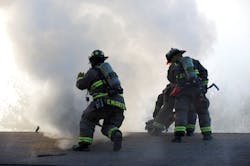Command & Control Success: Accountability: Beyond the Tags
Accountability is critical for measuring consistency of meeting the standards for delivering the highest level of service. The foundational standard of service that the fire service provides—saving lives and stopping property loss from fires—is just as important today as it was 100 years ago, based on the fact that civilian fire fatalities still number a few thousand per year. Civilian fatalities and firefighter fatalities from aggressive interior firefighting in comparison with lives lost, lives saved and overall progress must be evaluated in regard to making search of burning residential structures a higher priority. A level of accountability in the areas of what, when, why and how we search for possible trapped occupants must be created.
Years ago, some wanted to stop searching fire buildings if there wasn’t a report of trapped occupants. However, firefighters consistently have saved trapped occupants despite reports of vacant, not occupied, no one home, etc. As I wrote this column, five bodies were found in what was deemed to be a vacant house in Dayton, OH. This doesn’t mean that the firefighters should have been able to save them; in fact, they tried to make an interior advance but were pushed out by the fire’s intensity. I only use this as an example that a large number of civilians squat/live inside what the fire service classifies as vacant.
- Curt Isakson will present “Gallons Per Second 'Saving Lives'” at Firehouse Expo 2023.
I personally experienced numerous civilian fire deaths in what some call vacant structures but that I prefer to call dilapidated. Calling it dilapidated helps me to acknowledge that the structure hasn’t been properly maintained and causes a higher risk toward the safety of the firefighters that I command to extinguish and possibly search for trapped occupants. Anytime the economy crashes/there’s economic downturn, the number of people who live in these so-called vacant structures increases. This doesn’t mean that we search all structures regardless of what they are thought to be, but this is another reason for size-up and the need to look deeper into actual data on both firefighter deaths on the fireground from interior firefighting and civilian fire deaths. Only by comparing these two numbers can we define the worth of aggressive interior firefighting and searching the interior of burning structures. The fire service has used the number of 100 firefighter deaths per year for decades, but more than 75 percent of the 100 firefighter deaths weren’t even on the fireground. We must look deep at why we search, when we search, how we search, where we search and, absolutely, when we don’t search. The Firefighter Rescue Survey has captured data from more than 3,000 civilian rescues, and 29 percent of these were from structures that had no reports of trapped occupants.
We know that firefighting is dangerous and comes with unavoidable risk. Nevertheless, we absolutely should analyze every line-of-duty death (LODD) to determine what went wrong and how we can prevent it in the future. The 3,000 number is actual data that tells us that civilian lives are endangered frequently in structures that are on fire where no one reports that someone is inside. This in itself tells us the importance of searching structures that are on fire when the fire department has the staffing, experience and capability to search based on conditions on arrival.
The question from the street or front yard shouldn’t be to determine whether the structure is survivable by civilians but whether it’s occupiable by firefighters who are wearing proper bunker gear and SCBA, who have portable radios and thermal imaging cameras and who have the ability to provide some type of fire control tactics. Only after occupying the structure with firefighters searching for trapped occupants can the interior survivability by an unprotected civilian be determined. The fire service must hold itself accountable when it comes to properly providing life-saving services at structure fires.
Early in my career, the Florida State Fire Marshal’s office provided a basic class on fire investigations. Part of the curriculum was to leave in place any deceased civilians who were found inside of a fire for a full investigation to rule out foul play/arson. We allowed the mission of arson investigators to influence our mission as firefighters. In all of the more than 50 fires that I have had that involved civilian fire fatalities, only one was a murder with the fire the result of trying to cover it up. I was assigned to the nozzle, and it was obvious that this person was shot even under heavy smoke conditions.
We always will have the what-ifs and the small percentage of odd incidents, but neither of these shouldn’t define our strategy and tactics on the fireground.Rapid accountability
All departments that provide aggressive firefighting services that involve operating on the interior under limited visibility and aggressively searching structures for trapped occupants should have an accountability system that supports rapid movement and very visible accountability. This system must be more than boards, tags and other traditional accountability systems that are used at a stationary command post or dog tags that are collected at the point of entry. Yes, all of these can be important depending on the size of incident, the experience of the department based on frequency of fires, and the complexity of the fire, and they become even more important as an incident grows. However, none provides the rapid accountability that’s needed inside of or on top of a burning structure or in rapid evacuation. There have been numerous firefighter fatalities on the fireground where rapidly identifying who members were, the company they were assigned to that day and the given tactical assignment were issues. One example is Feb. 14, 1995, in Pittsburgh in a private dwelling on Bricelyn Street, when the identification of who was found unconscious inside of the burning house caused confusion and delay in looking for other missing firefighters (U.S. Fire Administration/Technical Report USFA-TR-078/February 1995).
Temporary assignments
The fact that 12 out of the 17 personnel on the first alarm of the Feb. 14, 1995, incident were in out-of-class assignments or were filling positions for other individuals added to the confusion. The officers and crew members weren’t used to working together, and their helmet markings didn’t indicate their temporary assignments.
Several individuals worked in higher level positions that day, because regularly assigned officers were absent or “moved up” that night. The initial incident commander (IC) was an acting battalion chief who normally functioned as a company officer and wasn’t accustomed to managing incidents at this level. One of the individuals who was rescued was a captain from an engine company, who was working an extra shift in a firefighter’s position on a ladder company, reporting to an acting lieutenant. Some of these individuals might have been unsure of their responsibilities or had difficulties with reporting relationships.
The type of incident in Pittsburgh happens frequently. Fortunately, we get lucky most of the time and everything works out. However, there have been numerous LODDs where firefighters couldn’t identify who was who inside or they thought that they were assigned to another company based on their helmet front piece or just because who they were and their long-standing assignment to another company. The number and color of the front piece on firefighters’ helmets should correspond with assignment for that given day.Helmets, bunker gear, SCBA
The most important accountability on the fireground is the ability for all ranks to track and rapidly identify who is who inside, outside and/or on the roof. The easiest way to accomplish this is by utilizing a helmet front piece that has the firefighter’s last name and a very legible company assignment that’s changeable based on company assignment for the particular day.
If a department has more than one company that uses the same numerical number, the department must implement a color system than identifies between Engine, Truck, Rescue, etc.
When I worked in Pensacola, only one numerical number was used. Engines were 1-6. Ladders had “1” in front of the Ladder Company. So, Ladder One downtown was Ladder 11 and Ladder 6 on the northside was Ladder 16. The three Rescues had a “3” in front of the company. So, Rescue 1 was Rescue 31 and so on. This was nice during a fire, because you could strictly hear the number and knew which company it was without hearing “Engine,” “Ladder” or “Rescue.”
Regardless of the system, it’s critical to understanding who is who and the company. Having the department name is secondary to the firefighter’s last name, and the member’s rank is more important than the department name.
Having the firefighter’s name on the bottom of the bunker coat is another very visible identification that helps with fireground rapid accountability.
SCBA should have the company number legible from the front, using the shoulder straps—preferably both—and the backside/bottle area of the SCBA for rapid identification of who the firefighter is and to what company that person is assigned. You still want to do a personnel accountability report (PAR), but SCBA identification helps company officers to rapidly visually confirm that they have their assigned firefighters while they still are wearing SCBA and among numerous companies on a controlled/chaotic situation (inside, on the roof, on the exterior in a collapse zone, and, particularly, when fireground operations go south and/or when command calls for a transition to exterior operations on exit).
Also, having the last name on the front of each mask is very helpful regardless of whether that member is inside or outside. I remember for years early in my career always having to ask firefighters who they were and what company they were assigned to when operating inside. It has gotten more difficult with today’s interior fire environment to identify who is who. As an interior chief officer, I really appreciate being able to rapidly identify officers by helmet color, rank, last name on the helmet front piece and last name on the mask. Our lieutenants wear red helmets, captains yellow and chiefs white. We went with the FDNY model on front pieces: black for engines, red for ladders, yellow for squads.
All of our radios have identifiers on them and are assigned to a particular riding position.Back up riding roster
All of this was very helpful a couple of months ago at a significant house fire where I operated as the operations chief in the front yard. An IC operated at the rear of a command vehicle across the street, and I communicated directly with an interior safety officer from start to finish. Four companies with a total of nine firefighters operated inside with two hoselines. They were stopping interior fire spread from a fully involved garage fire while other firefighters searched the other side of the house for any trapped occupants or pets.
The fire at the large house with a large attic space and a fully involved garage that was fueled by vehicles was more than we could stop from the interior. After the searches were completed, a smoke explosion in the attic caused me to decide that all companies should back out and go defensive. As nine firefighters tried to back out with two attack lines, the ceiling came down, and the HVAC ductwork wiring wrapped around one of the firefighters, which caused a delay/pileup in the foyer. As the operations chief in the front yard, I easily identified who was who and what company they were assigned as they exited the house as heavy fire took over the entire attic and dropped down into the foyer. As they came out, I directed each company to gather in four separate areas, close to each other, so the safety officer and I could properly account for all nine firefighters based on helmet front pieces, names on the mask and SCBA company identifiers. We also called for a PAR, but this PAR was made possible for each company officer based on the same visible identification markings that were used.
About the Author
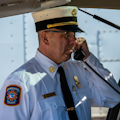
Curt Isakson
Curt “Ike” Isakson is a 30-plus-year veteran of the fire service. He worked for Escambia County, FL, Fire Rescue for 25 years. Isakson previously worked nine years for the Pensacola, FL, Fire Department, where he was assigned as a company officer on Heavy Rescue 31. His fire service experience started at a young age as a junior firefighter with the Midway, FL, Fire District; he rose through the ranks to captain. Isakson's identification of the need for a series of special-interest fire conferences spawned the development of County Fire Tactics, which covers officer development, command officers, water on fire, high-rise operations, and leadership and tactics.
